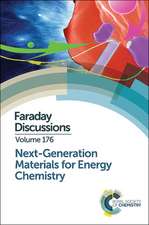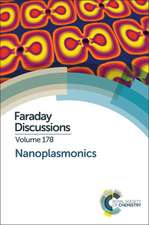Electric Contacts: Theory and Application
Cu Else Holm Prefață de J.B.P. Williamson Autor Ragnar Holmen Limba Engleză Paperback – 30 noi 2010
| Toate formatele și edițiile | Preț | Express |
|---|---|---|
| Paperback (1) | 739.21 lei 43-57 zile | |
| Springer Berlin, Heidelberg – 30 noi 2010 | 739.21 lei 43-57 zile | |
| Hardback (1) | 1053.34 lei 43-57 zile | |
| Springer Berlin, Heidelberg – 1967 | 1053.34 lei 43-57 zile |
Preț: 739.21 lei
Preț vechi: 901.48 lei
-18% Nou
Puncte Express: 1109
Preț estimativ în valută:
141.49€ • 153.74$ • 118.93£
141.49€ • 153.74$ • 118.93£
Carte tipărită la comandă
Livrare economică 21 aprilie-05 mai
Preluare comenzi: 021 569.72.76
Specificații
ISBN-13: 9783642057083
ISBN-10: 364205708X
Pagini: 512
Ilustrații: XV, 484 p.
Dimensiuni: 155 x 235 x 27 mm
Greutate: 0.78 kg
Ediția:Softcover reprint of hardcover 4th ed. 1967
Editura: Springer Berlin, Heidelberg
Colecția Springer
Locul publicării:Berlin, Heidelberg, Germany
ISBN-10: 364205708X
Pagini: 512
Ilustrații: XV, 484 p.
Dimensiuni: 155 x 235 x 27 mm
Greutate: 0.78 kg
Ediția:Softcover reprint of hardcover 4th ed. 1967
Editura: Springer Berlin, Heidelberg
Colecția Springer
Locul publicării:Berlin, Heidelberg, Germany
Public țintă
ResearchCuprins
I. Stationary Contacts.- II Thermal Contacts.- III Sliding, Contacts.- IV Electric Phenomena in Switching Contacts.- Appendices.- § I. Elasticity, plasticity and hardness.- A. Introduction.- C. Plastic deformations. Dislocations.- D. Mathematics of plastic yielding.- E. Indentation in an isotropic semi-infinite body, produced by a spherical indenter (ball).- F. The ball and pyramid indentation tests. Hardness.- G. Influence of friction on the indentation.- H. Diffusion effects.- I. The work consumed by a plastic deformation. Examples.- § II. Electronic conduction in solids.- A. Introduction.- B. General concepts concerning conduction.- C. Quantization of the electrons in a crystal and the constitution of a band.- D. Influence of the temperature on the distribution (or partition) of electrons on cells in metals.- E. Current carriers in semiconductors.- F. Mobility of current carriers. Resistance.- G. Surface potential barrier of a metal. Thermionic emission of electrons.- I. Metal-semiconductor contact.- A. Heat capacity.- B. Thermal conduction.- § IV. Probability. Noise.- A. Normal distribution.- B. Probability paper.- D. Electrical noise.- § V. Structure, electrical and thermal conductivity of carbons 404 A. Introduction. Graphite lattice.- B. Carbon grades. 406 C. Graphitization.- D. Electrical conductivity of carbons.- E. Heat conductivity of carbons.- § VI. Hydrodynamic or thick film lubrication.- § VII. Metal whiskers 417 A. Whiskers formed from the solid metal.- B. Whiskers rapidly formed from metal vapor.- C. Mechanical and magnetic properties of whiskers.- D. Metallic dendrites in semiconductors.- § VIII. Some fundamental formulas concerning electric discharges.- A. Introduction. Kinetic fundamentals.- B. Drift velocity.- D. Plasma.- E. Current in vacuumrestricted by the space charge of the current carriers.- § IX. Theory of the electric arc.- A. Introduction.- B. Cathode layer.- C. Emission of primary electrons from the cathode.- D. The ion current in the cathode layer.- F. Summary of the results presented in Table (IX,5).- G. Power balance at the cathode.- H. Power balance at the anode.- I. Voltage-current characteristics of arcs.- J. Pinch effect.- § X. Tables.- § XI. Diagram XI in two copies, one detachable.- Author and literature index.- Errata.
Caracteristici
Includes supplementary material: sn.pub/extras
















